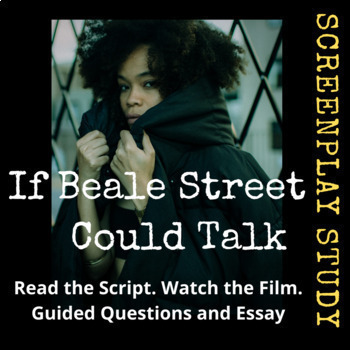Film Study: "If Beale Street Could Talk" Unit for Reading the Screenplay
- Google Docs™

Description
Screenplay, film study, movie guide and essay writing all in one unit.
Award winning director and screenwriter of “Moonlight” Barry Jenkins wrote and directed the screenplay for this film adaptation of James Baldwin’s book If Beale Street Could Talk. The result is phenomenal.
Reading a screenplay is all of the emotion, all of the visualization and impact, none of the fluff. The author has to make the reader picture the scene and fall in love, or they get rejected outright by the studio. This is why I love when I can get my hands on the screenplay of a good movie and teach it as a class text.
This story is about love and an exploration of the American Dream as only James Baldwin and Barry Jenkins can do. Based on Baldwin’s book, this film brings us the story of Tish and Fonny, the rare love they have, and the nearly insurmountable obstacles they face.
Each lesson includes a warm-up journal that relates to a central idea in that day’s reading. Next, there is a fun online review quiz on the material from the last lesson. These Kahoot! quizzes are self grading and very easy to do together as a class or assign as distance learning. After reading the text, there are comprehension questions for almost every page of this powerful script. At only 105 pages long, this screenplay is packed with details and subtext that speaks volumes. Also included are exact minute marks from the film (available on Hulu) that correlate to each lesson. Finally, there is a closing journal to reflect on the warm up and the text for that day. The unit culminates with a writing project including 6 prompts to choose from, a graphic organizer to collect evidence, and a rubric.
Everything is fully editable for you, and is ready to assign to Google Classroom now.
Included:
- Table of Contents
- Link to Screenplay
- Intro to reading a screenplay graphic
- 6 lessons, each with:
- Warm up Journal Entry
- Comprehension questions
- Minute marks with clips to the film that align with each lesson
- Supplemental data and material to enhance the background information in text
- Exit ticket writing
- Final analytical essay with 6 question choices and rubric included
“Every black person born in America was born on Beale Street, born in the back neighborhood of some American city, whether in Jackson, Mississippi, or in Harlem, New York. Beale Street is our legacy. This novel deals with the impossibility and the possibility, the absolute necessity, to give expression to this legacy.
Beale Street is a loud street. It is left to the reader to discern a meaning in the beating of the drums.” -James Baldwin





